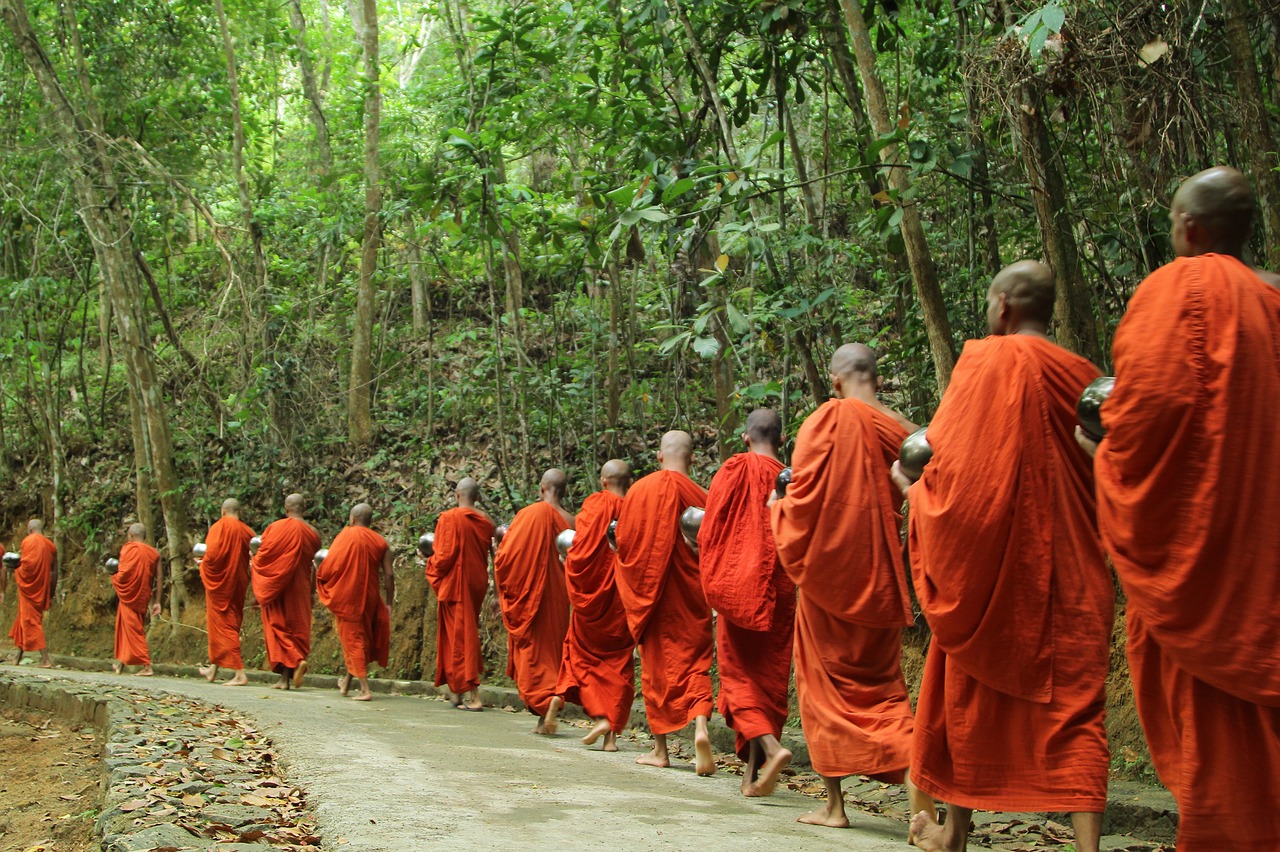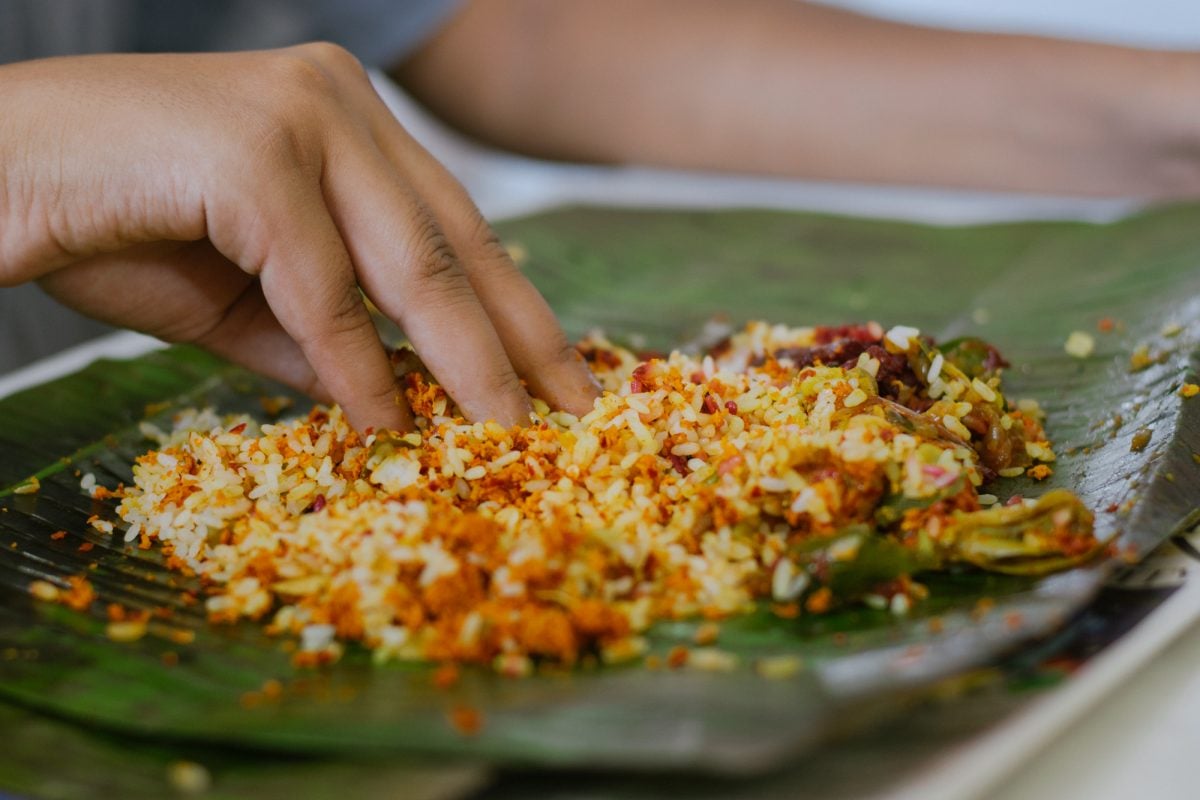Sri Lankan Customs , Etiquette and Cultural Insight :
Learn how to dress appropriately, and interact respectfully with locals and religious sites.

In Sri Lanka, Buddhism is the predominant religion with over 70% of the population practising it. The remainder of the population is Christian, Muslim, or Hindu.
Show monks respect at all times. If you’re on a packed bus, offer them a seat (unless you’re an old or disabled person). However, if you are a woman, especially, avoid shaking hands with monks. Alternatively, you can extend the customary welcome, which entails slightly bending and putting your hands together in a prayer-like motion.
Avoid facing away from or standing next to any nearby Buddha statues. When in doubt, observe how the people in your immediate vicinity behave. This also applies to posing for pictures; while it’s acceptable to snap a picture of a statue, the subject of the picture should be facing Buddha rather than standing next to or behind it.
A Buddhist monk’s head should never be touched or caressed, not even by small children at temples. They should be respected since they are the community’s religious leaders.
Wearing apparel with images of the Buddha or any other deity is prohibited. It is regarded as impolite and inconsiderate, and it can make authorities angry. Keep your Buddha tattoo concealed if you have one.
When entering a temple, cover your legs and shoulders, take off your shoes, and cover your head. Additionally, you should never enter someone’s house wearing shoes.
All guests to Hindu and Buddhist temples ought to dress suitably. This entails removing your shoes and headgear, covering your shoulders and legs, and entering Buddhist temples. Beachwear is offensive and inappropriate. The precise moment in huge temples to remove your shoes and hats might occasionally be unclear, so if in doubt, go with the locals. Finally, keep in mind that when the tropical sun heats the stone beneath your feet to oven-like temperatures, going barefoot around temples can occasionally be more difficult than you might anticipate. However, no one will mind if you wear socks.
Two other traditional Buddhist observances are only loosely followed in Sri Lanka, though you should never have yourself photographed posing with a Buddha image (that is, with your back to the image). The first is the prohibition against pointing your feet at a Buddha image, which is not as strictly enforced as it is, say, in Thailand. However, you do occasionally see people sitting in front of Buddhas with their legs neatly tucked under them. On the other hand, not many people follow the ancient Buddhist guideline that you should only walk around dagobas in a clockwise manner.

With some variations, Hindu temples have the same clothing and shoe codes. Non-Hindus are not allowed to enter the inner shrine in some; men must remove their shirts before entering in others; and women are occasionally prohibited completely.
A resident monk or priest will give you a tour of select Buddhist and Hindu temples, and you will be asked to donate afterwards. Unofficial “guides” will occasionally appear in other locations and insist on showing you around in exchange for payment. If you don’t desire the services of unofficial guides, try not to feel compelled to accept them.

- Buddhists generally hold the belief that humans have multiple lifetimes and are reborn.
- They should strive to improve their behavior in each existence until they achieve "Nirvana" since they will learn lessons from each.
- One of the five vows made by Buddhists is 1. to never kill or injure any living thing. 2. Not to take anything that is not offered freely or to steal it. 3. To manage libidinal urges. 4. Refrain from lying. 5. Refraining from using drugs or alcohol.
- Hinduism features a wide variety of deities, all of which are facets of Brahman, the everlasting source of all things, such as Ganesh, Shiva, Vishnu, and Parvatand Kali.
- Religion affects business in two ways: directly and indirectly. The most common belief is fatalism or the idea that someone greater is in charge.
- People will therefore consult religion when making decisions.
Travel Etiquette in Sri Lanka

1. How should I greet people in Sri Lanka?
In Sri Lanka, a customary greeting entails slightly bending your head and pressing your palms together in front of your chest and under your chin.
The person you welcome will determine what you say when you do this.
You can say “Namaste,” which is Hindi and widely used here if you want to be safe. Say “Ayubowan” to someone you know in Sinhalese and “Vanakkam” to someone you know in Tamil when extending a greeting.
In less formal settings, you could hear individuals ask “kohomada,” which translates to “how are you doing?”

2. Can you shake hands in Sri Lanka?
Although handshakes are customary in Sri Lanka, there are a few rules to follow. Although intersex handshakes are not popular, men and women can shake hands with one another.
Wait for her cue if you are a man greeting a woman. She will extend her hand if she wants to shake hands.
If you are comfortable doing so, you should extend your hand for a handshake when a woman greets a man. However, keep in mind that he will be waiting for your signal and will not extend his hand first.

3. How should I address people in Sri Lanka?
Unless they indicate you on first-name terms, you should always address someone by their title and then their surname. Sri Lankans place great importance on titles and honorifics, therefore use them whenever appropriate!

4. Is there a dress code I should follow in Sri Lanka?
Sri Lankans have a more casual approach toward clothing. But, you might want to make sure you dress modestly—this goes for both men and women—to make sure the locals feel at ease around you.
Wearing modest clothing in this situation essentially entails covering your knees and shoulders.

5. How can I avoid offending Sri Lanka?
It’s crucial to keep in mind that mistreating Buddhist artifacts and pictures while out and about is a serious offense.
Thus, in addition to abstaining from wearing any Buddha-related clothing or skin, you should also refrain from facing Buddha statues with your back to them or pointing your feet at them.

6. Are there any rules on taking photos in Sri Lanka?
Buddha statues are normally fine for photos, but you have to make sure that everyone in the photograph is facing the statue and not standing next to it or facing the other way.
As with many other nations, you should refrain from taking pictures of government structures, military installations, or VIP cars.
Asking someone before taking their picture is also considered courteous, even if they might request payment.

7. Which hand should I use for shaking hands and eating in Sri Lanka?
You should only use your right hand when eating, shaking hands, or passing something to someone since your left hand is only for personal hygiene. Of course, you can use both hands if the object is hefty.

8. Anything else I need to know about etiquette in Sri Lanka?
It is believed that the feet are the dirtiest portion of the body and the head the most sacred. As a result, you should refrain from touching someone’s top of your head, especially a toddler.
Additionally, you ought to refrain from placing your feet on furniture or pointing their bottoms at other people.
Use your entire hand to point at anything if you must, as using your index finger to do so is considered impolite.
Indeed, civility is highly valued by Sri Lankans. Try not to raise your voice if you disagree with someone because that could make them lose face, and face is very important to Sri Lankans.

9. Is it easy for vegetarians to eat in Sri Lanka?
While it’s true that meat and fish are not typically consumed on religious holidays in Sri Lanka, vegetarians will be happy to know that there will be plenty of delicious food available to them if they happen to be in your company.

10. Will I need to eat with my hands in Sri Lanka?
Instead of using silverware, Sri Lankans eat with their hands—more precisely, their right hand.
If you request cutlery, most restaurants will provide it to you, but why not try? The secret is to combine the rice and curry and then use your right hand’s forefingers to roll the mixture into little balls. Don’t lick your fingers when you’re done; usually, a sink is available for hand washing.
It is required of you to wash your hands before serving food or eating, whether you are in a public or private setting.

11. Should I clear my plate at the end of a meal in Sri Lanka?
Leave a small amount of food on your plate if you’ve had enough; this indicates that your appetite has been sated. You’ll know you’re still hungry if you leave your plate empty.

12. Is it easy to get hold of alcohol in Sri Lanka?
One of the main reasons Sri Lanka is a great destination for a school vacation is that alcohol is very hard to come by.
Furthermore, the local drinking culture isn’t very strong. This is because a number of the major religions in the nation are in fact against alcohol. Therefore, you won’t often find alcohol supplied with meals.

13. What do I need to know if I’m invited to a meal at a Sri Lankan’s home?
If you are asked to have a meal at someone’s house, be advised that socializing typically occurs before supper.
This could mean that it takes several hours from the time you arrive until the meal is served, so it’s best to have a snack before you go.
Additionally, you should be ready to depart very quickly following the lunch.
Also, take note that declining offered beverages is rude.




Comment (0)